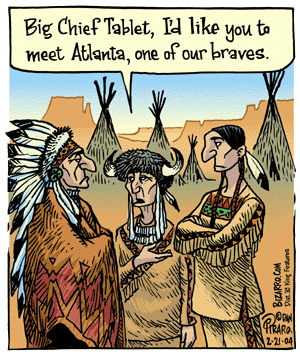 Another Stereotype of the Month entry:
Another Stereotype of the Month entry:
 Another Stereotype of the Month entry:
Another Stereotype of the Month entry:
Superficially, this cartoon seems to be making fun of Atlanta Braves fans. It suggests the team was named for a real "brave" named Atlanta. The silliness of the suggestion mocks the fans who think their baseball team has some connection to Indian culture.
The problem isn't Dan Piraro's attempt at social commentary (it's too weak to call it humor). The problem is his use of standard clichés while attempting social commentary.
For starters, the cartoon shows stereotypical Plains Indians: a chief, medicine man (?), warrior, and tipis. If Piraro had depicted Indians from the Southeast, the cartoon would've been more appropriate.
True, without the stereotypes, it might've been harder for the average reader to recognize the Indians and thus the point of the cartoon. But my purpose isn't to make life easy for cartoonists by acknowledging the usefulness of stereotypes. It's to point out the stereotypes and let the chips fall where they may.
If you're wondering what "Big Chief Tablet" refers to, I wondered too. The answer seems to be:
The Big Chief tablet was for many years the most popular brand of paper writing tablet among school children and hopeful novelists in the United States and exemplified the lined writing tablet as a communications medium. The tablet featured a native American with full headdress on the cover. The Big Chief Writing Tablet copyright was originally held by William Albrecht at the Western Tablet Company in St. Joseph, Missouri, and was later sold to the Mead Corporation, which also manufactured a Son of Big Chief tablet.
I guess you could say Piraro was mocking "Big Chief Tablet": the idea of associating an exalted Indian leader with mundane writing paper. But you could also surmise he was mocking Indian chiefs with funny names. Since the "Tablet" reference is obscure these days, it's unclear how most people will take it. Who knows whether they'll fathom his intent?
Even the mesas in the background are stereotypical. They imply Indians were (and are) "out there" in the desert somewhere, far from civilization. Showing the tipis half a mile from a fort or trading post might've been more accurate, but that would've ruined Piraro's message.
Finally, the cartoon, like so many Bizarro cartoons, offers a subtle meta-message. Namely, that Indians are a race of the past, primitive and strange, not like the rest of us. Once again, for better or worse, Indians are the only ethnic group he uses in his cartoons. That factor alone makes even his better efforts worse.
Related links
Tipis, feather bonnets, and other Native American stereotypes
Team names and mascots
Native comic strips vs. comic books
|
. . . |

|
All material © copyright its original owners, except where noted.
Original text and pictures © copyright 2007 by Robert Schmidt.
Copyrighted material is posted under the Fair Use provision of the Copyright Act,
which allows copying for nonprofit educational uses including criticism and commentary.
Comments sent to the publisher become the property of Blue Corn Comics
and may be used in other postings without permission.